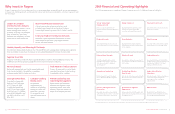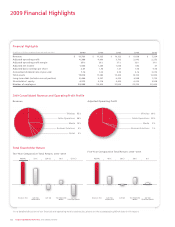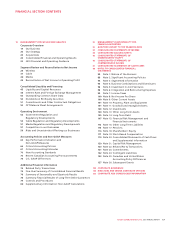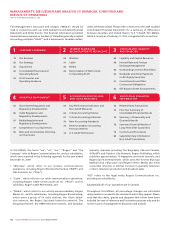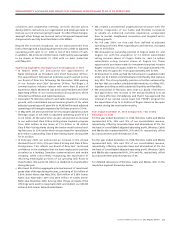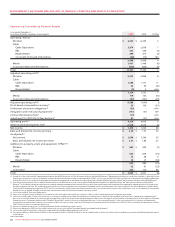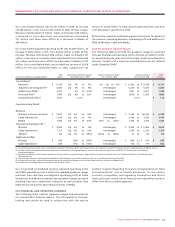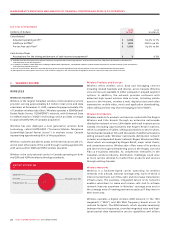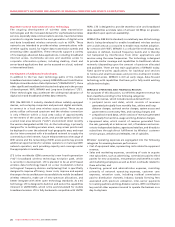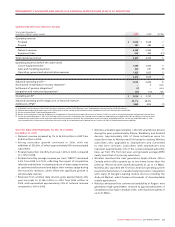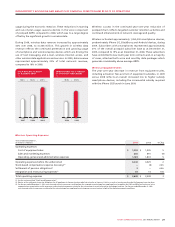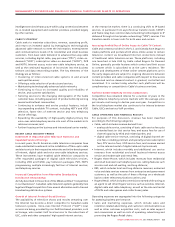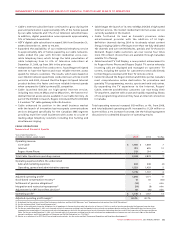Rogers 2009 Annual Report Download - page 21
Download and view the complete annual report
Please find page 21 of the 2009 Rogers annual report below. You can navigate through the pages in the report by either clicking on the pages listed below, or by using the keyword search tool below to find specific information within the annual report.
ROGERS COMMUNICATIONS INC. 2009 ANNUAL REPORT 25
MANAGEMENT’S DISCUSSION AND ANALYSIS OF FINANCIAL CONDITION AND RESULTS OF OPERATIONS
GPRS and EDGE technologies for wireless data transmission.
Wireless’ UMTS/HSPA technology is deployed in 850 MHz and 1900
MHz, and the network covers 85% of Canada’s population.
Wireless holds 25 MHz of contiguous spectrum across Canada in
the 850 MHz frequency range and 60 MHz in the 1900 MHz frequency
range across the country, with the exception of southwestern
Ontario, northern Québec, and the Yukon, Northwest and
Nunavut territories, where Wireless holds 50 MHz in the 1900 MHz
frequency range.
In addition, Wireless participated in the AWS spectrum auction
in Canada which concluded on July 21, 2008. Wireless acquired
20 MHz of AWS spectrum, which operates in the 1700/2100 MHz
frequency range, across all 13 provinces and territories with
winning bids that totalled approximately $1.0 billion, or
approximately $1.67/MHz/pop.
Wireless also holds certain broadband fixed wireless spectrum
in the 2300 MHz, 2500 MHz and 3500 MHz frequency ranges. In
September 2005, Wireless, together with Bell Canada, announced
the formation of an equally-owned joint venture called Inukshuk
to construct a pan-Canadian wireless broadband network based
on the evolving World Interoperability for Microwave Access
(“WiMAX”) standards. Both companies have contributed fixed
wireless spectrum holdings to the joint venture, along with access
to their respective cellular towers and network backhaul facilities.
The fixed wireless network acts as a wholesale provider of capacity
to each of the joint venture partners, who in turn market, sell,
support and bill for their respective service offerings over the
network. During 2009, Inukshuk acquired 92 MHz of additional
2.3 gigahertz (“GHz”) spectrum in the provinces of Ontario and
Quebec for $80 million from Look Communications and converted
the spectrum licence to a Broadband Radio Service (“BRS”) licence.
Pursuant to government policy, one-third of this spectrum was
returned to Industry Canada.
In the third quarter of 2009 Rogers entered into a joint venture with
Manitoba Telecom Services (“MTS”) for the purpose of building a
joint HSPA 3G Wireless Network in the province of Manitoba. Once
completed in 2010, this joint network will cover approximately 96%
of the Manitoba population.
WIRELESS STRATEGY
Wireless’ goal is to drive profitable subscriber and revenue growth
within the Canadian wireless communications industry, and its
strategy is designed to maximize cash flow and return on invested
capital. The key elements of its strategy are as follows:
• Enhancing its scale and competitive position in the Canadian
wireless communications market;
• Focusingonvoiceanddataservicesthatareattractivetoyouth,
families, and small and medium-sized businesses to optimize its
customer mix;
• Delivering on customer expectations by improving handset
reliability, network quality and customer service while reducing
subscriber deactivations, or churn;
• Increasing revenue from existing customers by utilizing
analytical tools to target customers likely to purchase enhanced
services such as voicemail, caller line ID, text messaging and wireless
data services;
• Enhancing sales distribution channels to increase focus on
targeted customer segments;
• Maintainingthemosttechnologicallyadvanced,highqualityand
pervasive wireless network possible; and
• LeveragingrelationshipsacrosstheRogersgroupofcompanies
to provide bundled product and service offerings at attractive
prices, in addition to implementing cross-selling, joint sales
distribution initiatives and infrastructure sharing initiatives.
RECENT WIRELESS INDUSTRY TRENDS
Focus on Customer Retention
The wireless communications industry’s current market penetration
in Canada is estimated to be 69% of the population, compared
to approximately 93% in the U.S. and approximately 129% in the
United Kingdom, and Wireless expects the Canadian wireless
industry to continue to grow by approximately 4 to 5 percentage
points of penetration each year for the next several years. This
deeper penetration drives a need for increased focus on customer
satisfaction, the promotion of new data and voice services and
features, and customer retention generally.
Demand for Sophisticated Data Applications
The ongoing development of wireless data transmission
technologies has led wireless device developers, such as handsets
and other hand-held devices, to develop more sophisticated
handsets and other smartphone type devices with increasingly
advanced capabilities, including access to e-mail and other
corporate information technology platforms, news, sports,
financial information and services, shopping services, photos,
music, applications, and streaming video clips, mobile television
and other functions. Wireless believes that the introduction
of such new applications will drive continued growth of wireless
data services.
Increased Competition from Other Wireless Operators
As fully described in the section of this MD&A entitled “Competition
in our Businesses”, Wireless faces increased competition from
incumbent wireless operators as well as new entrants.
20092008
2007
2008
2007
2009
$73.93$75.41$72.21
WIRELESS POSTPAID
MONTHLY ARPU
($)
20092008
2007
2008
2007
2009
1.06%1.10%1.15%
WIRELESS POSTPAID
MONTHLY CHURN
(%)


